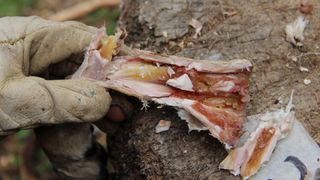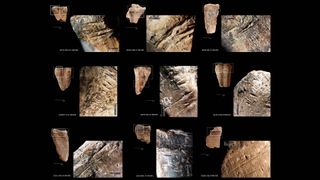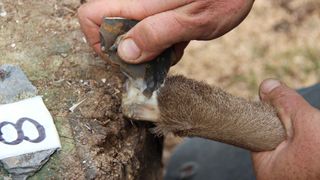Bones Filled with Marrow Served as Prehistoric Humans' 'Cans of Soup'
Mmmm ... marrow.

People who lived hundreds of thousands of years ago may not have had pantries or supermarkets, but they stocked up on food when they could, researchers recently discovered.
Evidence from a cave in Israel dating back more than 400,000 years suggests that after butchering their animal prey, Paleolithic humans didn't eat everything immediately. Rather, they stored bones packed with fat and tasty, nutrient-rich marrow to crack open and eat later — much as people today might open and enjoy a can of soup.
These are the earliest clues about food storage in ancient human societies, hinting that their survival was not as hand-to-mouth as once thought, according to a new study.
Related: Back to the Stone Age: 17 Key Milestones in Paleolithic Life
"Bone marrow constitutes a significant source of nutrition and, as such, was long featured in the prehistoric diet," study co-author Ran Barkai, a senior lecturer in archaeology at Tel Aviv University (TAU), said in a statement. Fats were especially important to people who were hunter-gatherers, as they relied "almost exclusively" on animals for their diet and did not have access to carbohydrates, the study authors reported.
"Until now, evidence has pointed to immediate consumption of marrow following the procurement and removal of soft tissues," Barkai said. "In our paper, we present evidence of storage and delayed consumption of bone marrow."

Archaeologists examined more than 80,000 animal bones and remains found at the Qesem Cave near Tel Aviv; the location dates to between 420,000 and 200,000 years ago, according to the study. Animals that were butchered and eaten by people who lived in the region at the time included hoofed mammals, tortoises, birds and even a few carnivores; their most common prey was Persian fallow deer (Dama dama mesopotamica).
Sign up for the Live Science daily newsletter now
Get the world’s most fascinating discoveries delivered straight to your inbox.
Not all of the deers' bones were brought back to the cave; most of them were left behind when the animal was butchered, save for the skulls and the long leg bones. What's more, the leg bones showed cut marks on the shafts that differed from those resulting from the butchering of the animals. The scientists suspected that these cuts were performed later, to remove dried skin that had been wrapped around the bones to preserve the marrow for future meals.
Experiments helped the researchers to test their hypothesis. First, they wrapped long animal bones called metapodials in skin, and set them aside to see if that would preserve the edible nutrients inside. Weeks later, they sliced off the skin and broke the bones open, comparing the cut marks to the ones found in the ancient bones from the cave.

"We discovered that preserving the bone along with the skin for a period that could last for many weeks enabled early humans to break the bone when necessary and eat the still nutritious bone marrow," lead study author Ruth Blasco, a researcher with TAU's Department of Archaeology and Ancient Near Eastern Civilizations, said in the statement.
"The bones were used as 'cans' that preserved the bone marrow for a long period until it was time to take off the dry skin, shatter the bone and eat the marrow," Barkai added.
Around the middle of the Pleistocene epoch, the geological period that began around 2.6 million years ago and lasted until around 11,700 years ago, human communities underwent "economic, social and cognitive transformations," the study authors wrote. These so-called marrow cans used by Stone Age humans are signs of that change, setting the stage for even more dramatic shifts in human adaptation to come in the millennia that followed, the researchers said.
The findings were published online Oct. 9 in the journal Science Advances.
- 8 Grisly Archaeological Discoveries
- In Photos: 130,000-Year-Old Evidence of Humans in California
- Photos: Ice-Age Animal Bones Unearthed During LA Subway Construction
Originally published on Live Science.


Mindy Weisberger is an editor at Scholastic and a former Live Science channel editor and senior writer. She has reported on general science, covering climate change, paleontology, biology, and space. Mindy studied film at Columbia University; prior to Live Science she produced, wrote and directed media for the American Museum of Natural History in New York City. Her videos about dinosaurs, astrophysics, biodiversity and evolution appear in museums and science centers worldwide, earning awards such as the CINE Golden Eagle and the Communicator Award of Excellence. Her writing has also appeared in Scientific American, The Washington Post and How It Works Magazine.
